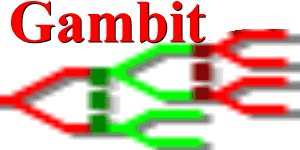Printing and exporting games#
Gambit supports (almost) WYSIWYG (what you see is what you get) output of both extensive and strategic games, both to a printer and to several graphical formats. For all of these operations, the game is drawn exactly as currently displayed on the screen, including whether the extensive or strategic representation is used, the layout, colors for players, dominance and probability indicators, and so forth.
Printing a game#
To print the game, press Ctrl-P, select , or click the printer icon on the toolbar. The game is scaled so that the printout fits on one page, while maintaining the same ratio of horizontal to vertical size; that is, the scaling factor is the same in both horizontal and vertical dimensions.
Note that especially for extensive games, one dimension of the tree is much larger than the other. Typically, the extent of the tree vertically is much greater than its horizontal extent. Because the printout is scaled to fit on one page, printing such a tree will generally result in what appears to be a thin line running vertically down the center of the page. This is in fact the tree, shrunk so the large vertical dimension fits on the page, meaning that the horizontal dimension, scaled at the same ratio, becomes very tiny.
Saving to a graphics file#
Gambit supports export to five graphical file formats:
Windows bitmaps ( .bmp )
JPEG, a lossy compressed format ( .jpg , .jpeg )
PNG, a lossless compressed format ( .png ); these are similar to GIFs
Encapsulated PostScript ( .ps )
Scalable vector graphics ( .svg )
To export a game to one of these formats, select , and select the corresponding menu entry.
The Windows bitmap and PNG formats are generally recommended for export, as they both are lossless formats, which will reproduce the game image exactly as in Gambit. PNG files use a lossless compression algorithm, so they are typically much smaller than the Windows bitmap for the same game. Not all image viewing and manipulation tools handle PNG files; in those cases, use the Windows bitmap output instead. JPEG files use a compression algorithm that only approximates the original version, which often makes it ill-suited for use in saving game images, since it often leads to “blocking” in the image file.
For all three of these formats, the dimensions of the exported graphic are determined by the dimensions of the game as drawn on screen. Image export is only supported for games which are less than about 65000 pixels in either the horizontal or vertical dimensions. This is unlikely to be a practical problem, since such games are so large they usually cannot be drawn in such a way that a human can make sense of them.
Encapsulated PostScript output is generally useful for inclusion in LaTeX and other scientific document preparation systems. This is a vector-based output, and thus can be rescaled much more effectively than the other output formats.
